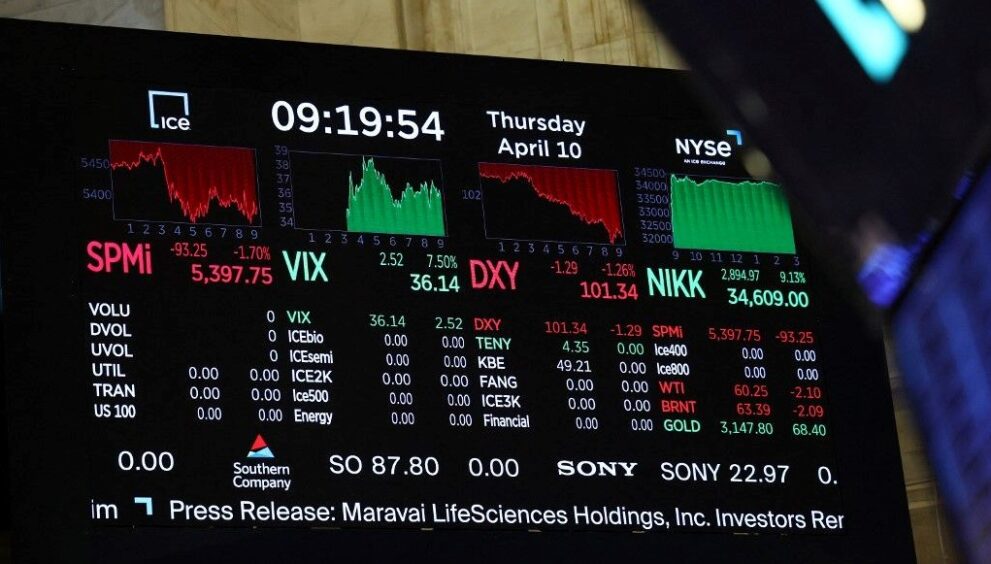New York Stock Exchange Closed Lower

The New York Stock Exchange ended the day with a drop due to ongoing concerns about US President Donald Trump’s tariff policy.
At the close, the Dow Jones index lost over 1000 points, decreasing by 2.50% to 39,593.66 points. The S&P 500 index fell by 3.46% to 5,268.05 points, and the Nasdaq index declined by 4.31% to 16,387.31 points. Despite a rally on Wednesday following the delay decision made by President Trump less than 24 hours after the implementation of reciprocal tariffs, selling pressure increased due to renewed tariff concerns. Trump, in a post on the Truth Social media account, mentioned that additional tariffs to trade partners were suspended for 90 days, applying a 10% basic tariff rate during this period. However, Trump revealed that he had raised the tariff on China to 125%. Following this announcement, the European Union (EU) mentioned that it would suspend the measures prepared against the US steel and aluminum imports for 90 days, while the Chinese government stated that they would not retreat in the escalating tariff tension. The White House clarified that the customs tariff rate imposed on China, announced by Trump to have been raised to 125%, only covered reciprocal tariffs, while the total tariff rate reached 145% when including those implemented due to the fentanyl crisis. Analysts expressed concern that the escalating trade tensions between Washington and Beijing overshadowed positive economic data in the US and optimism in trade negotiations, triggering fears that the trade war between the world’s two largest economies would cause lasting damage to economic growth, leading to the selling pressure. Additionally, analysts advised caution and evaluation of economic consequences for investors, expecting continued market volatility due to uncertainties despite the suspension of additional tariffs for 90 days. The VIX Index, also known as the “fear index,” surpassed a value of 40 with a 21% increase. In terms of macroeconomic data, the figures announced today in the US indicated a continued slowdown in inflation rates. The Consumer Price Index (CPI) decreased by 0.1% in March on a monthly basis, falling below expectations with a 2.4% annual increase. As a result, it was the first time since May 2020 to see a monthly decrease in the CPI. The core CPI, which does not include fluctuating energy and food prices, also recorded an increase below expectations with a 0.1% monthly and 2.8% annual rise in March. Analysts pointed out that there had not been an upward movement in inflation figures yet, mentioning that the impact of the imposed tariffs was expected to be seen in the coming months. The number of first-time filers for unemployment benefits in the US increased by 4,000 people to 223,000 in the week ending on April 5th, remaining in line with market expectations.
TARIFF UNCERTAINTY AFFECTS THE FED
The uncertainty surrounding tariffs complicates the path of the US Federal Reserve’s (Fed) monetary policy, and statements from Fed officials are closely monitored. Chicago Fed President Austan Goolsbee described tariffs as a “stagflationist shock” that put the Fed’s price stability and maximum employment targets at odds. Goolsbee noted that the quicker the uncertainty diminished, the faster the Fed could reduce borrowing costs. Dallas Fed President Lorie Logan stated that tariffs higher than anticipated would likely increase both unemployment and inflation. Kansas City Fed President Jeff Schmid mentioned that if they had to balance price stability objectives with full employment targets, they would prioritize keeping inflation in check. Fed Board Member Michelle Bowman stated that the US economy continued to remain strong, but the impacts of trade policies were uncertain. Analysts mentioned that for more information on the inflation outlook and the economy’s trajectory in the US, tomorrow’s Producer Price Index (PPI) and the financial reports of major banks like JPMorgan Chase, Wells Fargo, and Morgan Stanley would be closely followed by investors.






















































































































































































































































































































































































































































































































































































































































































































































































































































































































































































































































































































































































































































































































































































































































































































































































































































































































































































































































































































































































































































































































































































































































































































































































































































































































































































































































































































































